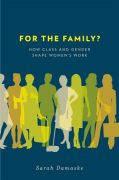
Based on research with 80 women, For the Family? debunks the myth that financial needs determine women's workforce participation, revealing that financialresources make it easier for women to remain at work, not easier to leave it.In the emotional public debate about women and work, conventional wisdom holds that middle-class women "choose" whether or not to work, while working class"need" to work. Yet, despite the recent economic crisis, national trends showthat middle-class women are more likely to work than working-class women.In this timely volume, Sarah Damaske debunks the myth that financial needs determine women's workforce participation, revealing that financial resources make it easier for women to remain at work, not easier to leave it. Departing from mainstream research, Damaske finds not two (working or not working), but three main employment patterns: steady, pulled back, and interrupted. Looking at the differences between women in these three groups, Damaske discovers that financial resourcesmade it easier for middle-class women to remain at work steadily, while working-class women often found themselves following interrupted work pathways in which they experienced multiple bouts of unemployment. While most of the national attention has been focused on women who leave work, Damaske shows that bothmiddle-class and working-class women found themselves pulling back from work,but for vastly different reasons. For the Family? concludes that the public debate about women's work remains focused on need because women themselves emphasize the importance of family needs in their decision-making. Damaske argues that despite differences in work experiences, class, race, and familial support, most women explained their work decisions by pointing to family needs, connecting work to familyrather than an individual pursuit.In For the Family?, Sarah Damaske at last provides a far more nuanced and richer picture of women, work, and class than conventional wisdom offers. INDICE: CHAPTER 1: Women's Work Trajectories: Need, Choice and Women's Strategies PART I: EXPECTATIONS ABOUT WORK CHAPTER 2: The Shape of Women's Work Pathways CHAPTER 3: A Major Career Woman? How Women Develop Early Expectations about Work PART II: WORK PATHWAYS CHAPTER 4: Staying Steady: Good Workand Family Support Across Classes CHAPTER 5: Pulling Back: Divergent Routes to Similar Pathways CHAPTER 6: A Life Interrupted PART III: NEGOTIATING EXPECTATIONS CHAPTER 7: For the Family: How Women Account for Work Decisions CHAPTER 8: Having it All? Egalitarian Dreams Deferred Appendix Notes ReferencesIndex
- ISBN: 978-0-19-979149-1
- Editorial: Oxford University
- Encuadernacion: Rústica
- Páginas: 256
- Fecha Publicación: 13/10/2011
- Nº Volúmenes: 1
- Idioma: Inglés
